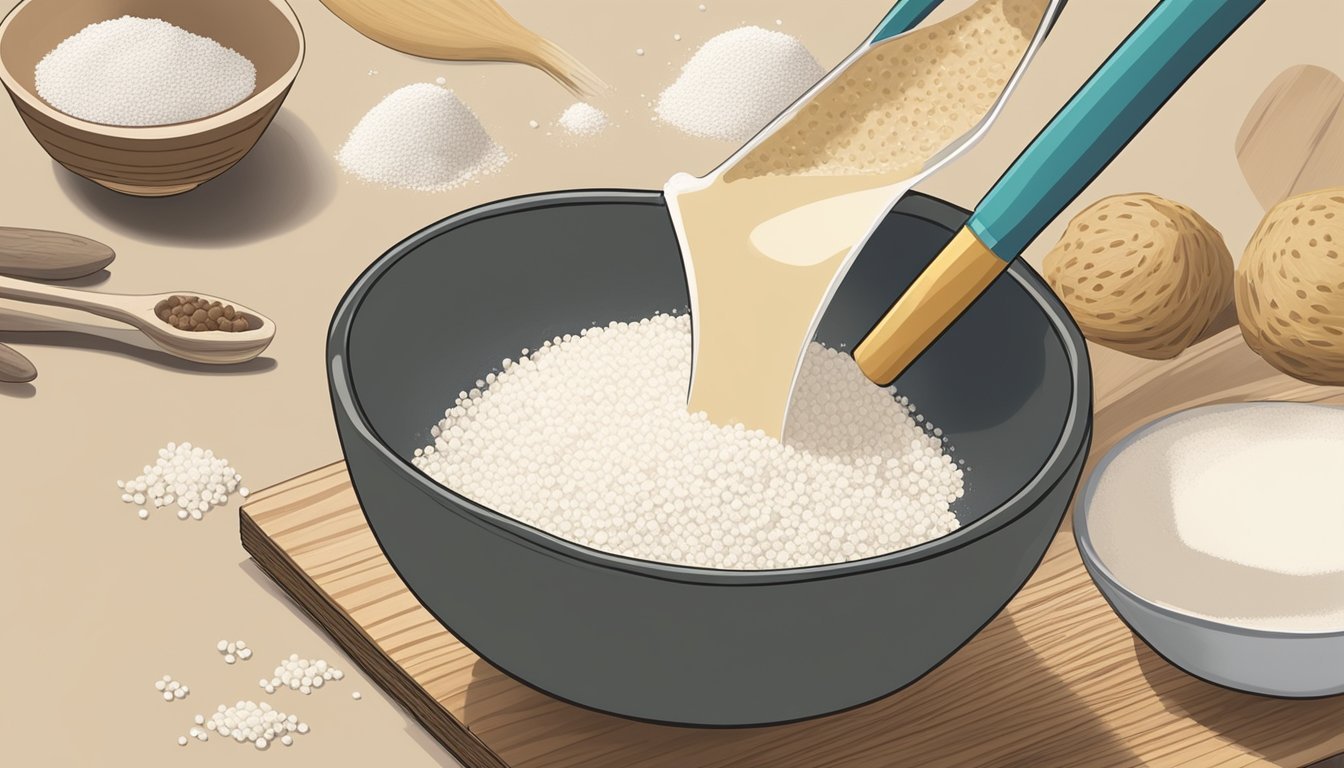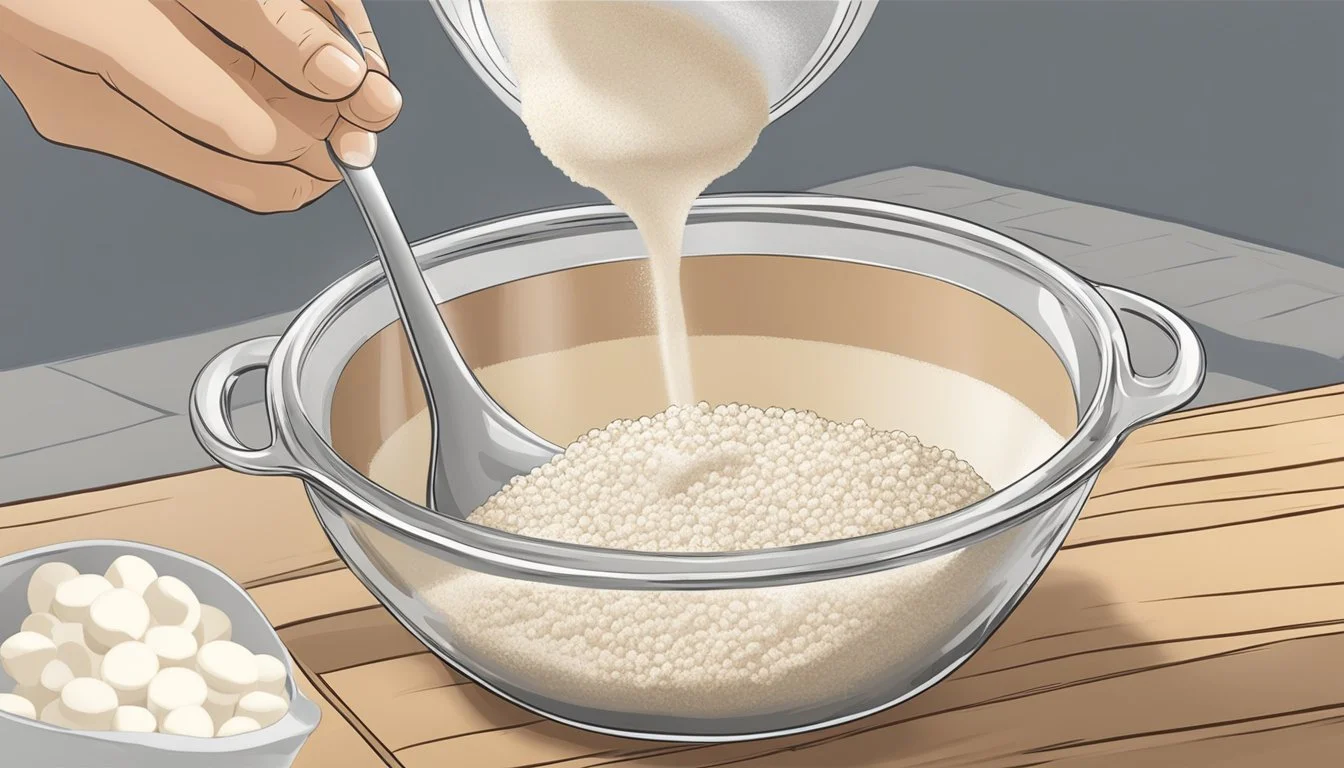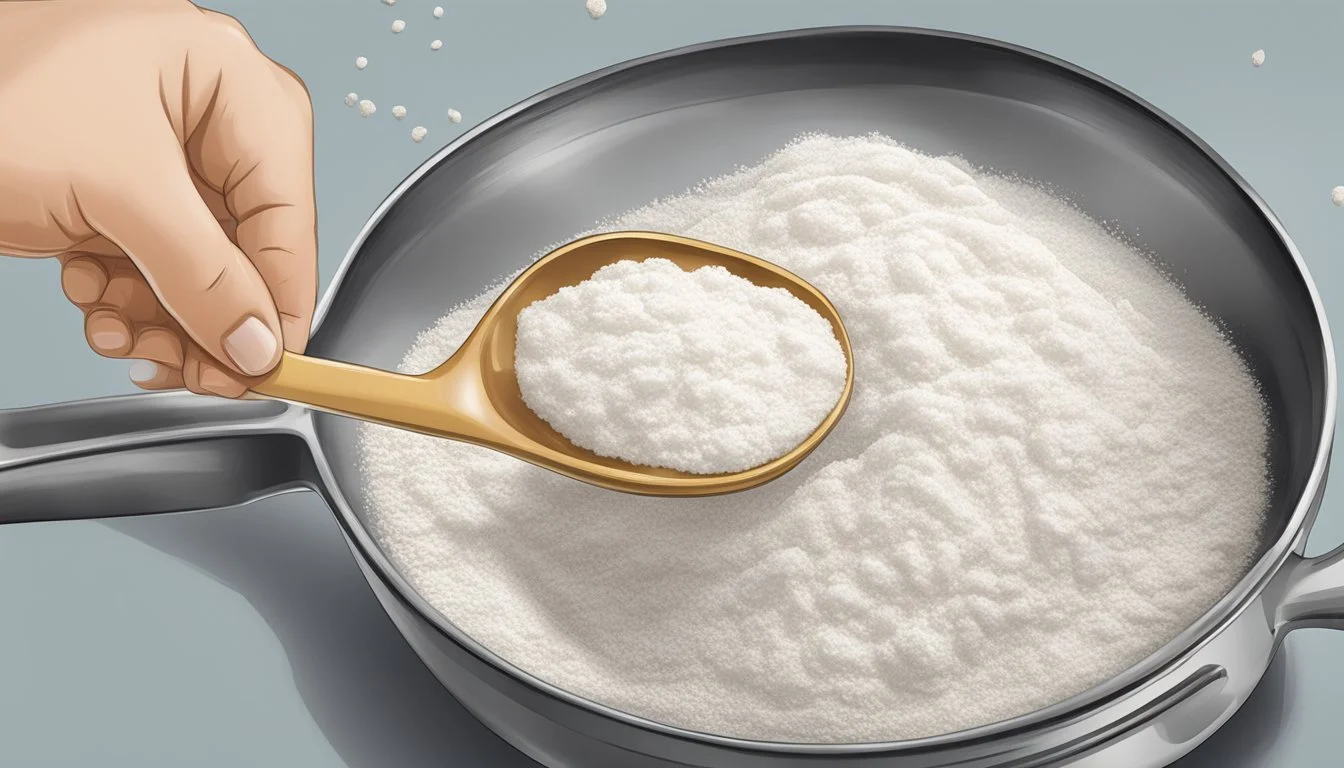How to Substitute Arrowroot Powder for Tapioca Starch
A Simple Swap Guide
In the realm of gluten-free cooking, finding te right thickening agent for recipes is essential for texture and consistency. Arrowroot powder and tapioca starch are two such agents that are widely used in culinary applications. These starches are not only useful for individuals following a gluten-free diet but also for those looking to substitute traditional thickeners like wheat flour or cornstarch.
Arrowroot powder is a starch derived from the tubers of the arrowroot plant and is touted for its ease of digestion and its neutral flavor, making it an excellent choice for delicate sauces and clear glazes. Tapioca starch, extracted from the cassava root, is similarly flavorless and provides a glossy finish to dishes. It holds up well under prolonged cooking and freezing.
When a recipe calls for tapioca starch and it's not available, arrowroot powder can step in as a substitute. Both starches can be replaced on a 1:1 basis, meaning that if you require one tablespoon of tapioca starch, you can confidently use one tablespoon of arrowroot powder instead. When using arrowroot as a substitute, it’s important to add it towards the end of cooking, as it is more heat-sensitive than tapioca starch and can lose its thickening abilities if overheated.
Understanding Arrowroot Powder
Arrowroot powder, derived from the rhizomes of the Maranta arundinacea plant, is a starchy substance frequently used in cooking and baking. It is obtained from the tropical arrowroot plant, which is cultivated for its tubers that yield this versatile powder.
Nutritionally, arrowroot powder is valued for its carbohydrate content, mainly in the form of resistant starch, which is known for its minimal impact on blood sugar levels. This form of starch promotes digestion by supporting healthy bowel movements and is often recommended for its ease of digestion.
Arrowroot powder contains small amounts of fiber and protein, adding to its nutritional value. It is particularly noted for being gluten-free and grain-free, making it an ideal ingredient for individuals following a paleo diet or those with gluten sensitivities.
These characteristics contribute to arrowroot's popularity as a thickening agent in sauces, soups, and baking. Its neutral flavor ensures it does not alter the taste profiles of dishes. Due to its fine granular nature, it blends smoothly into liquids, offering a glossy sheen to the final product.
Substituting arrowroot powder for tapioca starch may affect the final result of recipes due to its unique properties. While tapioca starch can provide a chewy texture, arrowroot powder may result in a slightly different consistency. However, it can combine with other starches to create a substitute for wheat flour, especially in cake recipes.
In summary, arrowroot powder is a nutritious, gluten-free, and easily digestible starch with versatile culinary applications.
Tapioca Starch Characteristics
Tapioca starch, derived from the cassava root, is widely used as a thickening agent in cooking and baking applications. This white, fine powder possesses a wealth of properties that make it a staple in many kitchens.
Neutral Taste: One of the defining characteristics of tapioca starch is its neutral flavor profile. This allows it to be used in a variety of dishes without altering the taste, making it versatile for both savory and sweet recipes.
Thickening Properties: As a thickening agent, tapioca starch excels in creating a desired consistency in sauces, gravies, and soups. It imparts a glossy finish to liquids, offering a visually appealing texture that is often desired by chefs and home cooks alike.
Texture Contributions: When added to baked goods, it contributes to the overall texture, often resulting in a crisp or chewy mouthfeel, depending on the preparation method.
Performance in Freezing: Tapioca starch shows resistance to freezing and thawing, which maintains the original texture of the food product, making it suitable for items that need to be frozen for storage.
Carbohydrate Content: It's primarily composed of carbs and offers minimal protein or fat, which should be considered in dietary planning.
Application Tips:
When using as a substitute for arrowroot powder, employ a 1:1 ratio.
Mix with a cold liquid before adding to hot mixtures to prevent clumping.
Utilize tapioca starch to elevate the texture and aesthetics of culinary creations, while also considering its impact on dietary carbohydrate intake.
Arrowroot as a Substitute for Tapioca
When cooking or baking, arrowroot flour is an excellent substitute for tapioca starch. They both serve as thickeners and have a neutral flavor, which makes them versatile in a variety of dishes. However, there are a few key points one must remember to achieve the desired texture and consistency.
Arrowroot flour, also known as arrowroot starch, offers a clear, glossy appearance to sauces and fillings, making it suitable for glazes and desserts. It's a preferable choice in dishes with a higher acidity level since arrowroot maintains its thickening ability in acidic environments, unlike tapioca starch.
Here’s a quick guide to substituting arrowroot for tapioca starch:
Use a 1:1 ratio when substituting arrowroot for tapioca starch.
Arrowroot is ideal for thickening acidic liquids, while tapioca is better for dairy-based sauces due to arrowroot's tendency to become slimy.
For long cooking processes, consider another substitute, as arrowroot can break down and lose its thickening properties.
Tapioca Starch Arrowroot Flour as Substitute Texture Similar texture; may be less stringy with arrowroot Flavor Neutral; suitable for use in a wide range of dishes Acidity Arrowroot performs well; tapioca does not Dairy Replace arrowroot with tapioca for dairy dishes Cooking Time Shorter cooking time recommended for arrowroot
When baking, arrowroot flour is a gluten-free flour option and it can be used as a tapioca starch substitute without compromising on the final product's quality. For those with gluten sensitivities, arrowroot starch is an appropriate alternative that does not affect the taste or texture of baked goods significantly.
Optimizing Texture and Consistency
When substituting arrowroot powder for tapioca starch, chefs must consider the impact this switch will have on texture and consistency. Tapioca starch, known for its ability to withstand long cooking processes, is often preferred as a thickening agent when a glossy sheen is desired in the finished product.
Arrowroot Powder:
Yields a slurry that is clearer and less viscous.
Provides a silkier mouthfeel but may not hold up as well under freezing and thawing conditions.
Can result in a cloudy appearance if overmixed.
Tapioca Starch:
Known for its ability to give a sticky and heavier consistency to dishes.
Ideal to create a glossy finish, particularly in sauces and fruit pies.
Retains texture after freezing, unlike arrowroot.
When replacing arrowroot with tapioca starch, use a 1:1 ratio—one tablespoon of tapioca starch per one tablespoon of arrowroot powder. Here's a quick reference:
Ingredient to Replace Amount of Arrowroot Powder Tapioca Starch Substitute Arrowroot Powder 1 tablespoon 1 tablespoon Tapioca Starch
Chefs should mix the starch with a cold liquid first to create a slurry before incorporating it into their dish to avoid clumping. They can then add this slurry to the dish to enhance texture, bind ingredients, and achieve the desired consistency without altering the taste. Remember, the slurry should be added at the end of the cooking process to prevent a breakdown of the thickening properties.
Incorporating in Different Recipes
When substituting arrowroot powder for tapioca starch, it's important to consider the unique characteristics of both ingredients and how they behave in different types of recipes. Arrowroot tends to have a neutral flavor and works best at lower temperatures, while tapioca starch can handle higher heat and offers a glossy finish to dishes.
Sauces and Gravies
In sauces and gravies, arrowroot is an excellent thickener and can be used on a 1:1 ratio with tapioca starch. Arrowroot's strength lies in its ability to thicken at low heat, which helps prevent the sauce from becoming slimy. It's vital to whisk the arrowroot powder into a cold liquid before adding it to the hot sauce to avoid clumps.
Gravies: It is recommended to mix arrowroot with a bit of cold water to form a slurry before incorporating it into the gravy.
Sauces: For fruit sauces and glazes, arrowroot powder will not only thicken but also provide a clear, glossy sheen.
Baked Goods and Desserts
Arrowroot is gluten-free and thus suitable for gluten-free recipes. It's found in cookies and sweet dishes where a tender and chewy texture is preferred. In baked goods and desserts like pies, custards (how long do custards last?), and puddings, replace tapioca starch with an equal amount of arrowroot powder for a similar consistency.
Pies and Custards: Use arrowroot powder to achieve a firm yet smooth consistency without affecting the flavor.
Cookies and Desserts: For that slightly chewy texture, incorporate arrowroot in place of tapioca starch. Mix with the dry ingredients before combining with the wet.
Soups and Fillings
Arrowroot acts as a thickener in soups and fillings. Because it thickens at lower temperatures, it should be added towards the end of the cooking process. For soups that require a long cooking time, it's best to add the arrowroot later to avoid breaking down and losing its thickening properties.
Soups: Add the arrowroot slurry when the soup is almost finished to thicken up to the desired consistency.
Fillings: In fruit fillings and jams, arrowroot will thicken without the need for extended cooking, also it will result in a clear, glossy finish to your dish.
Alternative Starches and Flours
When substituting arrowroot powder with tapioca starch, it's important to understand the variety of alternatives available and how they might affect your recipe.
Starch and Flour Alternatives
Starches:
Tapioca Starch: Derived from the cassava root, it's a direct substitute for arrowroot.
Cornstarch: A common substitute that offers a similar texture; use half the amount of arrowroot powder.
Potato Starch: Works well for thickening but can be heavier than arrowroot.
Rice Flour: A fine option, particularly in Asian cuisine; can be grainier.
Sweet Rice Flour: Stickier and can be used to create a chewier texture in recipes.
Nut and Grain-Free Flours:
Almond Flour: Contains more protein and fat but is not a direct substitute.
Coconut Flour: Highly absorbent and may require additional liquid.
Cassava Flour: From the whole cassava tuber and has more fiber than tapioca starch.
Binding Agents:
Xanthan Gum: Often used in gluten-free baking; only a small amount is needed.
Psyllium Husk: High in fiber and a binder in gluten-free baking.
Agar Agar: A vegan gelatin substitute made from algae.
Special Considerations for Substitutes
When altering ingredients like starches and flours:
Health Considerations: Nut flours, like almond flour, cater to keto diets due to low carbohydrate content.
Dietary Restrictions: Options like cornstarch may not suit those with corn allergies.
Cooking Qualities: Substitutes like cassava flour may differ in absorbency and texture from tapioca starch.
Nutritional Content: While starches like tapioca provide thickness, they might have less fiber and protein compared to alternatives such as coconut flour.
Adjusting for Cooking Techniques
When substituting arrowroot powder for tapioca starch, chefs should consider the cooking technique involved in their recipe. Each thickener reacts differently under various conditions such as temperature and the presence of acids.
Long Cooking Times: Tapioca starch is preferred for recipes that require extended cooking times. It tolerates prolonged heat better than arrowroot, which can lose its thickening properties over time. If a recipe involving lengthy simmering calls for arrowroot, tapioca starch can be used in a 1:1 ratio as a substitute.
High Temperatures: Both arrowroot and tapioca starch are able to withstand high temperatures. However, for dishes that are cooked at high temperatures for short periods, such as quick stir-fries or flash baking, arrowroot can provide a glossy finish to sauces without affecting the consistency even when tapioca is used as a replacement.
Low Temperature: For recipes that are cooked at a low temperature, tapioca starch can be used without any significant alterations in the final texture of the dish.
Acidic Liquids: Arrowroot powder is stable in acidic solutions, making it an excellent choice for thickening acidic dishes (What wine goes well with acidic dishes?). Tapioca starch can also be used, but it may not provide the same clarity in sauces or fillings when compared to arrowroot.
Acidic Dishes: When working with acidic components, such as fruits high in ascorbic acid, chefs might prefer arrowroot as it tends to keep its thickening abilities better in such conditions. However, tapioca can still serve as a substitute; chefs might just need to prepare for a slightly different texture and clarity in their final dish.
Health Considerations and Dietary Use
When substituing arrowroot powder for tapioca starch, individuals should consider dietary restrictions and health benefits. Both arrowroot powder and tapioca starch are gluten-free, making them suitable for individuals with celiac disease or gluten sensitivity. Furthermore, being grain-free products, they are compatible with a palean or grain-free diet.
Arrowroot Powder:
Nutrition: Arrowroot powder is low in calories and contains a moderate amount of B vitamins.
Dietary Restrictions: Suitable for gluten-free, vegan, and palean diets.
Health Benefits: It's easily digestible, making it a gentle choice for sensitive stomachs.
Allergies: Rarely allergenic, thus suitable for most individuals with dietary allergies.
Tapioca Starch:
Nutrition: Tapioca starch is also low in calories but lacks significant nutritional value.
Keto Diet: Not suitable for keto diets due to its high carbohydrate content.
Neutral Taste: It does not alter the flavor profile of dishes.
In conclusion, both thickeners serve well for various dietary needs. However, for those following a keto diet, neither arrowroot powder nor tapioca starch is ideal due to their carbohydrate content. Individuals should assess their nutritional needs, taste preferences, and health conditions when choosing between these substitutes.
Culinary Tips and Tricks
When substituting arrowroot powder with tapioca starch in cooking and baking, one should keep in mind that both serve as thickening agents derived from tropical plants. Tapioca starch, sourced from the cassava root, can replace arrowroot powder in a 1:1 ratio. This substitution becomes useful in recipes aiming for a smooth texture and a glossy sheen without the final product becoming opaque.
To create a slurry with tapioca starch, simply mix it with a cool liquid—ideally water—before combining it with hot ingredients. Consider using heavy cream instead of water to enrich the final dish with a creamy texture, especially in sauces and soups.
Baking Tips:
Pies and Pastries: Utilize tapioca starch to achieve a desirable consistency in fillings, as it holds up well during extended cooking times.
Binding Agent: Combine it with other flours for enhanced binding capabilities in recipes.
Cooking Advice:
Sauces and Gravies: Introduce the slurry slowly to hot liquids, stirring continuously to prevent clumping.
Dairy Consideration: Tapioca starch works harmoniously with dairy products, maintaining stability under heat and providing a consistently smooth result.
It's important to note that, unlike cream of tartar, tapioca doesn't act as a stabilizer for sugar syrups or meringues. However, its pure starch content makes it a versatile thickener across various culinary applications. Remember, while tapioca starch is not a direct derivative of the Marantaceae family like arrowroot, it performs remarkably similar functions in numerous recipes.
Understanding the Role of Starches in Cooking
Starches are fundamental in cooking as thickeners, playing a crucial role in the texture and consistency of various dishes. They are added to sauces, soups, and gravies, aiding in achieving the desired thickness and a glossy finish. The chosen starch can affect the final product significantly, from its translucency to its consistency.
Arrowroot and Cornstarch, both primarily used for thickening, have unique properties. Arrowroot starch is praised for its neutral taste and gluten-free qualities, making it an excellent choice for those with dietary restrictions. It also freezes well, thus preferred in dishes that require chilling.
Cornstarch is another common thickener, notable for its strong binding capabilities. However, it differs from arrowroot in a few key aspects. When cooking with cornstarch, one typically uses half the amount compared to arrowroot due to its higher thickening power. It is also important to be cautious of heat, as prolonged exposure can cause the mixture to thin.
Here is a simple comparison:
Property Arrowroot Starch Cornstarch Thickening Strength Moderate Strong Freezability Good Poor Gluten-Free Yes Yes Flavor Neutral Neutral Heat Tolerance High Moderate
Using either starch comes down to the requirements of the dish. It’s critical to understand each starch’s behavioral differences when heat is applied and how they interact with other ingredients. Chefs integrate starches like arrowroot and cornstarch to bind ingredients, while ensuring the end result maintains an enjoyable and appropriate consistency without altering the intended flavor.
Practical Applications in the Kitchen
When cooking or baking, one might run into a scenario where arrowroot powder is called for but not available. Tapioca starch stands out as one of the best substitutes for arrowroot powder due to its similar characteristics. Below are some practical applications:
Sauces and Gravies: Chefs often use tapioca starch as a thickener in sauces and gravies. An equal amount of tapioca starch can effectively replace arrowroot, measuring for measuring.
Baking: When baking gluten-free treats, tapioca starch can be utilized in a 1:1 ratio with arrowroot to secure the desired chewy, yet crisp texture, which benefits cookies and cakes alike.
Jams and Fillings: For a glossy sheen and the proper consistency in jams or pie fillings, replace arrowroot with instant tapioca. This will maintain the structured, yet spoonable consistency required for such desserts.
Desserts: In various desserts, where arrowroot is traditionally used as a thickening agent, tapioca starch can seamlessly fill this role without altering the taste.
Savory Dishes: Whether it’s a thick soup or a stew, tapioca starch is a reliable alternative, ensuring a smooth and desirable consistency.
Sweet Dishes: In sweet dishes, the neutral flavor of tapioca starch makes it an excellent choice as it won’t overshadow the dish’s intended taste profile.
Below is a quick reference for substitutions:
Arrowroot Powder Tapioca Starch Application 1 tsp 1 tsp Thickening sauces 1 tbsp 1 tbsp Baking 1/4 cup 1/4 cup Jams & fillings
Remember not to subject tapioca starch to prolonged high heat to preserve its thickening abilities, especially in savory applications.
Notes on Storage and Preservation
Storing arrowroot powder and tapioca starch correctly ensures their longevity and preserves their thickening properties. Both products should be kept in a cool, dry place away from direct sunlight. It’s recommended to store them in airtight containers to prevent the absorption of moisture, which could lead to clumping or spoilage.
Arrowroot Powder:
Derived from the Maranta arundinacea plant.
Shelf-life: Can last up to four years if stored properly. Be careful not to confuse with other starches as it is naturally gluten-free and low in calories.
Not ideal for: Freezing, as it can become slimy and lose its thickening capabilities.
Tapioca Starch:
Sourced from cassava roots, often found in Amazonian cuisine.
Shelf-life: Can also last several years if kept sealed in a cool, dry environment.
Suitable for: Both long cooking and freezing, maintaining a glossy sheen without altering taste.
When substituting arrowroot powder with tapioca starch for thickening purposes:
Use a 1:1 ratio.
For long cooking and recipes intended for the freezer, tapioca starch is preferable.
Tapioca can be used in a broader range of dishes, including both savory and sweet.
Corn Starch Alternative: Corn starch is a common substitute but requires different storage and usage considerations.
Ratio: Use half the amount of corn starch in place of arrowroot powder.
To maintain the quality of these starches, regular checks for odors or discoloration are advisable. If one notices changes in appearance or smell, it may indicate the product is no longer optimal for use.
Conclusion
When it comes to gluten-free cooking, both arrowroot powder and tapioca starch are viable thickening agents, each bringing its own characteristics to a dish. To substitute arrowroot powder for tapioca starch, a 1:1 ratio is typically recommended. This makes the process straightforward for home cooks and professionals alike.
Texture plays a significant role in cooking and baking, and it's important to understand how these substitutes affect the final product. Arrowroot tends to produce a glossy finish and is excellent for thickening at lower temperatures. However, it might not hold up as well under prolonged cooking. On the other hand, tapioca starch is resilient to long cooking times, making it suitable for recipes that require simmering.
For those attentive to the health aspects, both arrowroot and tapioca starch are gluten-free and thus suitable for those with gluten sensitivities or celiac disease. They are also both carbohydrates, though arrowroot is often celebrated for its potential health benefits and minimal flavor, which makes it a versatile thickener for both sweet and savory dishes.
Substitute Ratio Qualities of Arrowroot Powder Qualities of Tapioca Starch 1:1 Glossy finish, not heat stable Endures long cooking, versatile
In the absence of one, the cook can confidently interchange these starches while being mindful of their distinct properties. A well-informed selection can lead to successful culinary outcomes, ensuring dishes are of desired consistency and quality.







